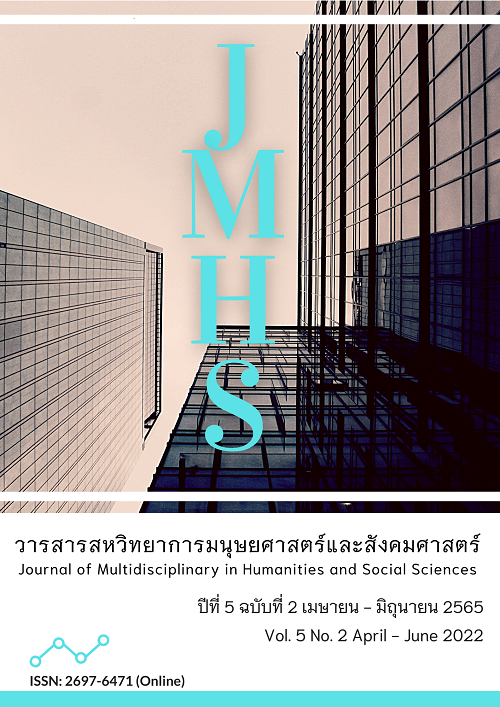A Study of Value and Motivation Toward the Sacred Objects of Buddhists
Main Article Content
Abstract
The purposes of this article were to: 1) study the origin and development of Thai sacred objects; 2) study the concept, values, and motivations of belief in the sacred objects; and 3) analyze the values and motivations of belief in sacred objects. This research was qualitative research by collecting information as well as in-depth interviews. The research results were found as follows:
- The various Buddha images and involved things such as Bodhi tree, etc. were made by Buddhists to remember the Buddha after his passing away after they found the Buddha images, they represented the Buddha in order to reflect the Buddha. Later on, the sacred objects have been created with wholesome faith in Buddha’s sacred power.
- The belief in the Buddhābhiseka ritual refers to performance with confidence in the holy power of Buddha, Dhamma, and Sangha, and the merits in sacred objects. Thai society, with continued Buddhist culture, believes that the Buddha’s sanctity resides in those images and comes from the power of belief in the objects’ sacredness. At present, the sacred objects have been changed to commercial flow.
- The value of motivation for belief in sacred objects of most Buddhists was that those who worship Buddhist sacred objects often escape from dangers or even survive from death like a miracle for this reason. The important values of righteous belief, faith in the Buddha, Dharma, and Sangha are practical, self-witnessed, and confidential. With such Buddhist sacred objects, one will be surely no danger, successful, so people generally accept the sacred objects completely.
Article Details

This work is licensed under a Creative Commons Attribution-NonCommercial-NoDerivatives 4.0 International License.
Views and opinions appearing in the Journal it is the responsibility of the author of the article, and does not constitute the view and responsibility of the editorial team.
References
ชินวรณ์ บุณยเกียรติ. (2564). อดีตรัฐมนตรีว่าการกระทรวงศึกษาธิการ. สัมภาษณ์, 2 พฤศจิกายน.
เดือน คําดี, (2541). ศาสนศาสตร์. กรุงเทพฯ: มหาวิทยาลัยเกษตรศาสตร์.
บรรจบ บรรณรุจิ. (2564). นักวิชาการทางพระพุทธศาสนา สถาบันพลังจิตตานุภาพ กรุงเทพมหานคร. สัมภาษณ์, 23 พฤศจิกายน.
ประเสริฐ รุ่งแสง (2564). อดีตหัวหน้าชุดปฏิบัติการพิเศษ (SEAL) กองทัพเรือ. สัมภาษณ์, 28 ตุลาคม.
ปิ่น มุทุกันต์. (2537). มงคลชีวิต. (พิมพ์ครั้งที่ 5). กรุงเทพฯ: คลังพิทยา.
พระพรหมคุณาภรณ์ (ป.อ. ปยุตฺโต). (2551). พจนานุกรมพุทธศาสน์ ฉบับประมวลศัพท์. (พิมพ์ครั้งที่ 11). กรุงเทพฯ: โรงพิมพ์มหาจุฬาลงกรณราชวิทยาลัย.
พระพรหมโมลี สุชาติ ธมฺมรตโน. (2564). รักษาการเจ้าคณะใหญ่หนเหนือ แม่กองบาลีสนามหลวง ผู้ช่วยเจ้าอาวาสวัดปากน้ำภาษีเจริญ วัดปากน้ำภาษีเจริญ กรุงเทพมหานคร. สัมภาษณ์, 18พฤศจิกายน.
มณี พยอมยงค์. (2539). วัฒนธรรมล้านนาไทย. กรุงเทพฯ: ไทยวัฒนาพานิช.
มหาจุฬาลงกรณราชวิทยาลัย. (2539). พระไตรปิฎกภาษาไทย ฉบับมหาจุฬาลงกรณราชวิทยาลัย. กรุงเทพฯ: โรงพิมพ์มหาจุฬาลงกรณราชวิทยาลัย.
มหาวิทยาลัยมหาจุฬาลงกรณราชวิทยาลัย. (2542). เก็บเพชรจากพระคัมภีร์พระไตรปิฎก. กรุงเทพฯ: โรงพิมพ์มหาจุฬาลงกรณราชวิทยาลัย.
ยิ่งยง เรืองทอง. (2542). สังคมและวัฒนธรรมในประเทศไทย. กรุงเทพฯ: ศูนย์มานุษยวิทยาสิรินธร.
วศิน อินทสระ. (2554). ศรัทธากับปัญญา. กรุงเทพฯ: ธรรมดา.
วันชัย สอนศิริ. (2564). สมาชิกวุฒิสภา. สัมภาษณ์, 29 ตุลาคม.
แสง จันทร์งาม. (2534). ศาสนศาสตร์. (พิมพ์ครั้งที่ 2). กรุงเทพฯ: ไทยวัฒนาพานิช.


